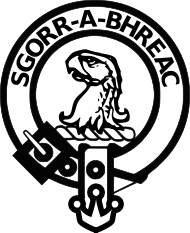Clan MacNicol
| Clan MacNeacail Clann MhicNeacail |
|||
|---|---|---|---|

Crest: A hawk's head erased Gules.
|
|||
| Motto | SGORR-A-BHREAC (Scorrybreac) | ||
| Slogan | Meminisse sed providere (Remember but look ahead) | ||
| Profile | |||
| District | Inner Hebrides | ||
| Plant badge | Juniper | ||
| Chief | |||
 |
|||
| John MacNeacail of MacNeacail and Scorrybreac | |||
| Chief of the Highland Clan MacNeacail | |||
| Seat | Ballina, New South Wales | ||
| Historic seat | Scorrybreac Castle and Castle MacNicol (Stornoway Castle). | ||
|
|||
|
|||
|
|||
Clan MacNeacail, sometimes known as Clan MacNicol, is a Scottish clan long associated with the Isle of Skye. Traditions states that, early in its history, the clan held the Isle of Lewis, as well as extensive territory on the north-western mainland. Further traditions, however, state that the clan lost its lands to the MacLeods of Lewis through the marriage of a MacNeacail heiress. The earliest member of the clan on record is one 14th century John "mak Nakyl", who is recorded amongst Edward I of England's powerful West Highland supporters during the Wars of Scottish Independence. John Barbour's 1375 epic, The Brus, suggests that by 1316, the clan had switched allegiance to Robert I, and made a decisive intervention in the new theatre of Anglo-Scottish conflict in Ireland. Despite the loss of lands in the following generation, the MacNeacails retained local influence: serving, according to tradition, as members of the Council of the Lords of the Isles. The next definite record of the clan, however, appears in the 16th century, when the MacNeacails were seated as landholders on Skye. In the 17th century, members of the clan began to Anglicise their surname from the Scottish Gaelic MacNeacail to various forms, such as Nicolson. Today the English variants of the Gaelic surname are borne by members of the clan as well as members of unrelated Scottish families, including the Lowland Clan Nicolson.
The heartland of the clan has been for centuries in Trotternish, on Skye. The earliest record of a MacNeacail in Trotternish occurs in 1507. Hugh MacDonald's 17th century History of the MacDonalds shows that the clan was seated on Skye even earlier, as it states that "MacNicoll in Portree" was a member of the council of the Lords of the Isles. There are several pedigrees which document the earliest line of the clan. One such pedigree is contained within the 15th century MS 1467. This pedigree concerns a certain Ewen who must have flourished in the 15th century; he is presented as the son of John, the son of Nicol. Although further successive generations are given, the names following Nicol tend to be garbled and cannot be taken back with any confidence. Nicol appears to have flourished at the turn of the 14th century, and was likely the eponymous ancestor of the clan. The garbled names further past Nicol tend to be a mixture of Gaelic and Norse names, which suggests that the clan's claim to a Scandinavian origin is not unlikely. During the High Middle Ages, Skye formed a part of the Norse-Gaelic Kingdom of the Isles, before being incorporated into the Kingdom of Scotland through the Treaty of Perth in 1266. The MacNeacails were also one of the families whom the Irish genealogist John O'Hart purported to trace back to Adam and Eve via the early kings of Ireland. According to this genealogy, some of the ancestors of Clan MacNicol include Breoghan, the Celtic king of Spain; and Lugaid Mac Con, High King of Ireland.. It is likely that the competing Norwegian and Celtic narratives of the clan's origins refer to two separate lines intertwined in a Norse-Gaelic marriage.
...
Wikipedia
